Efflorescence on Masonry
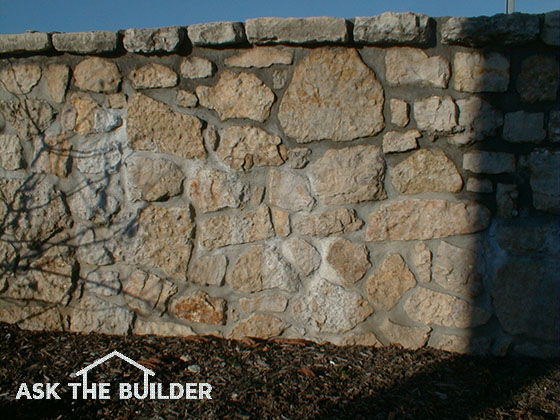
This wall has a bad case of efflorescence. The white minerals leaching from the mortar have seriously stained both the stone and the mortar.
Efflorescence on Masonry Tips
- Not a structural problem
- Salt in soil, brick or mortar is cause
- WATCH efflorescence videos below
- Do NOT wash with water!
- CLICK HERE to Get Tim's FREE & FUNNY Newsletter!
DEAR TIM: I feel our new home has some serious problems but our builder disagrees. The house is less than 6 months old but we have ugly white deposits that are leaching out of our chimney, a wing wall that juts from a corner of our home and a retaining wall
I feel there must be something wrong for this to happen. The more I scrub the worse the problem gets. What's wrong and what can be done to fix the problem? Andrew M., Loveland, OH
DEAR ANDREW: Don't put the noose around the builder's neck just yet. The white deposits you are seeing are probably not his fault, although there might have been some things he could have done during construction to minimize the presence of the powder.
No Harm No Foul
The first thing to realize is that these mineral deposits are just an aesthetic problem. They don't compromise the structural integrity of any of the masonry in and about your new home, but chronic water that gets into masonry can cause problems over time.
Source is Salts
The white powder you see is efflorescence. The brick, stone, concrete block, mortar etc. contain water soluble salts that are the source of the white deposits. Soil behind retaining walls can also contain these same salts.
These trapped salts are set into motion when water enters masonry. The water dissolves the salts and carries them through the masonry towards the surface. Sunlight and wind draw the water to the surface but as the water evaporates, the salts are left behind.
Years to Wear Out
The salts contained in the brick, mortar, stone, concrete block eventually exhaust themselves and the white mineral deposits simply go away. But salts within soil can persist for decades.
This is why efflorescence on the face of a retaining wall is almost impossible to cure unless you remove the backfill, clean the wall and apply an asphalt waterproofing compound on the back of the wall.
IMPORTANT TIP: Do NOT try to wash off the powder deposits with water or an acid-water solution.
Each time you try to wash the chimney and wall surfaces to remove the salts, you actually compound the problem. The water you use dissolves the salts again and carries them back into the mortar or the masonry.
The surfaces typically look fantastic when wet and you think you've solved your problem, but the white powder appears again when the surfaces dry within hours or days.
How To Stop It
To stop the efflorescence now, you must stop all water from entering the masonry surfaces. This is somewhat easy to do at the chimney and any exterior masonry walls, but far more difficult to do with the retaining wall.
If you stop the water, there is no transport medium to carry the soluble salts to the surface where you'll see them.
Efflorescence Video
Watch this video to grasp what you're up against.
Silane Siloxane Water Repellents
Your chimney and wing wall can be treated with a great silane-siloxane water repellent. This is a clear liquid you apply with a garden hand-pump sprayer. They'll travel deep into the masonry if you have a helper using a backpack leaf blower.
As you spray the wall with the clear liquid, the helper blasts the wall with the air from the blower. This air pushes the sealer deep into the masonry.
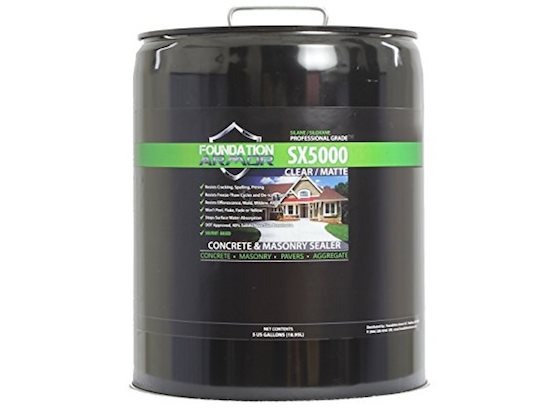
This is a magnificent silane - siloxane water repellent that soaks into concrete. CLICK THIS IMAGE NOW TO ORDER IT.
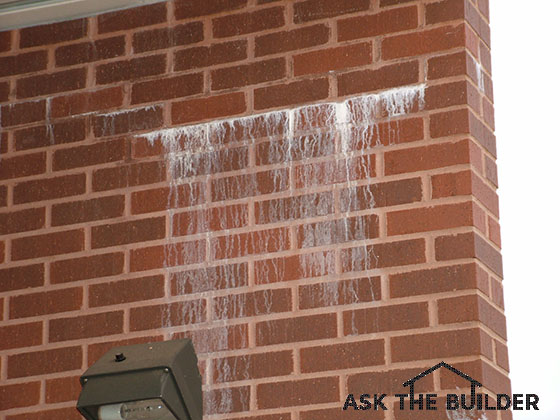
Here is classic efflorescence. This brick is at my daughter's school and is only 2-years old. This is a small wing wall and the top of it can get wet. Efflorescence is very common on new brick and stonework.
Retaining Wall Woes
The retaining wall that's backfilled with dirt should have been treated as it was built. The back side of the wall where the dirt touches it needs to be coated with an asphalt waterproofing compound.
If the wall builder had done this, even if it was just liquid asphalt, that would have stopped water infiltration into the wall.
Remove The Fill
It's very hard to do now as the fill behind the wall will have to be removed, the wall cleaned and allowed to dry and finally the back side of the wall can be waterproofed. Too bad this wasn't done when the wall was built.
It would have taken hours instead of the days it will now take to stop the efflorescence.
Mild Weather
I would not try to do any remedial work until the weather moderates. You want days where the temperature rises to 65 F or above to get excellent results from the sealants and water repellents.
Be sure to inspect the chimney crown for cracks that might allow water to enter the chimney's masonry core. If you discover cracks, you need a different elastomeric coating for the chimney crown.
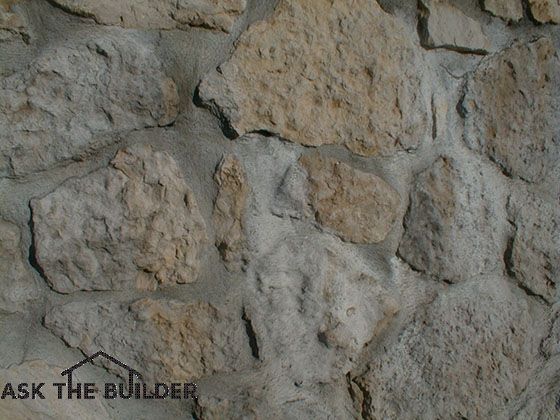
The one stone in the center bottom of this photograph is completely covered with a thick layer of minerals. It is perhaps the worst case of efflorescence I have ever seen other than deposits in a cave.
Tough Love Talk
I think you should have a discussion with your builder to see if he will help you out with the retaining wall fix. Perhaps he can excavate the fill and clean the wall and you apply the waterproofing compound. The builder can then backfill since he has access to equipment that can do it rapidly and easily.
Can You Wait?
Efflorescence happens. It is part of building new things. It eventually goes away on its own, but this process can take years, even decades. When possible, it's best to just let the problem diminish on its own.
Stopping water from entering masonry is the best way to make efflorescence stop. But it is not as easy as one might think. Water can enter masonry and travel up, down and sideways!
Rising Damp
You can actually get efflorescence on masonry walls caused by moisture in the soil that wicks up a wall. In Europe this is called the rising damp. It's almost impossible to cure this defect.
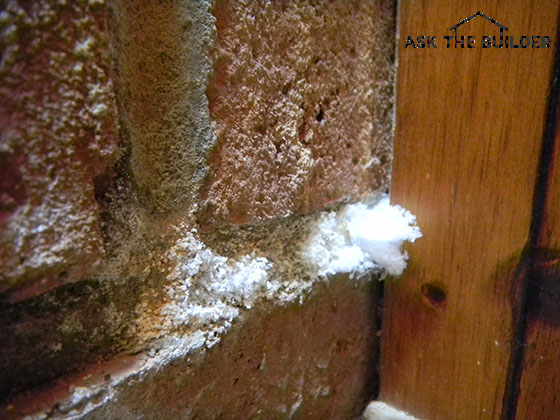
Efflorescence growing in the mortar of a brick fireplace. PHOTO CREDIT: Michael Hannum
Companion Articles: Efflorescence, Efflorescence on Masonry Surfaces, Efflorescence Removal, Efflorescence Publications
Over the years, I've seen many different spellings of efflorescence. Here's my growing list: effervesce, effervescence, effervescent, effleresants, effloreflance, efflorescence, efflorressance, effluorescence, eflorescence, eflorescents, ellforesce and ifflorescence.
Column 499
22 Responses to Efflorescence on Masonry